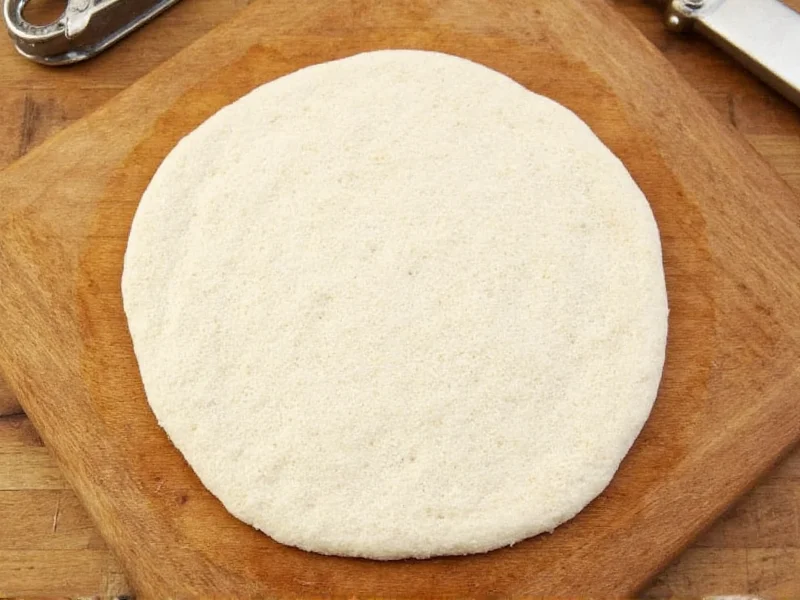For home pizza enthusiasts, understanding the proper use of cornmeal can transform your pizza-making experience from frustrating to flawless. Many home cooks struggle with dough sticking to the peel, ruining carefully assembled creations just before they reach the oven. The right application of cornmeal solves this common problem while enhancing your pizza's texture and flavor profile.
The Science Behind Cornmeal's Pizza Magic
Cornmeal works through a clever combination of physics and culinary science. Unlike wheat flour, cornmeal particles are larger and more irregularly shaped. When sprinkled on a pizza peel, these particles create thousands of tiny ball bearings between the dough and the surface. As the pizza transfers to the oven, the cornmeal either:
- Creates a physical barrier that prevents gluten strands from bonding with the peel
- Quickly dries out when exposed to oven heat, further reducing stickiness
- Adds minimal moisture compared to flour, preventing soggy crust issues
This mechanism explains why cornmeal outperforms regular flour for pizza transfers. The slight toasting that occurs during baking also contributes a subtle nutty flavor that complements traditional pizza ingredients.
Choosing the Right Cornmeal for Pizza
Not all cornmeal works equally well for pizza making. The grind size significantly impacts performance:
| Cornmeal Type | Grind Size | Pizza Suitability | Texture Result |
|---|---|---|---|
| Finely Ground | 0.2-0.5mm | Excellent | Subtle crunch, even distribution |
| Medium Ground | 0.5-1.0mm | Best overall | Ideal balance of texture and non-stick properties |
| Coarse Ground (Polenta) | 1.0-2.0mm | Poor | Excessive crunch, uneven cooking |
| Instant/Cheap Brands | Variable | Avoid | Bitter taste, inconsistent results |
Professional pizzaiolos typically recommend medium-grind cornmeal (sometimes labeled as "pizza dust") for home use. This grind provides the perfect balance between non-stick functionality and subtle textural enhancement without creating an unpleasantly gritty crust.
Proper Application Techniques
Using cornmeal correctly matters as much as choosing the right type. Follow these professional techniques for flawless pizza transfers:
- Preparation: Lightly dust your pizza peel with 1-2 teaspoons of cornmeal, focusing on the center where the dough will rest
- Dough Placement: Gently toss your stretched dough onto the prepared peel, giving it a small shake to ensure it's not sticking
- Assembly Test: Before adding toppings, gently rotate the dough to confirm it moves freely
- Transfer Technique: When ready to bake, use a jerking motion to slide the pizza onto your stone or steel
Avoid common mistakes like using too much cornmeal (which creates a messy pile under your pizza) or using coarse polenta that burns easily in high-heat ovens. For wood-fired or extremely hot ovens (above 600°F/315°C), consider reducing the amount slightly as the intense heat causes cornmeal to toast more quickly.
Cornmeal vs. Common Alternatives
While cornmeal remains the gold standard, several alternatives work in specific situations:
- Semolina flour: Provides similar non-stick properties with a slightly finer texture and milder flavor. Many professional pizzerias use semolina exclusively.
- Rice flour: An excellent gluten-free option that creates minimal flavor impact while preventing sticking.
- Flaxseed meal: Adds nutritional benefits but can burn at high temperatures.
- Regular wheat flour: Works in a pinch but absorbs moisture more readily, potentially creating sticky spots.
For traditional Neapolitan-style pizza, semolina often proves superior due to its finer texture. However, for New York-style or home oven baking, medium-grind cornmeal delivers the classic texture and flavor profile most pizza lovers expect.
Troubleshooting Common Cornmeal Issues
Even with proper technique, problems can occur. Here's how to solve them:
- Burning cornmeal: Reduce the amount used or switch to a finer grind. This commonly happens in ovens above 500°F (260°C).
- Excessive crunch: You're likely using coarse polenta instead of proper pizza cornmeal.
- Dough still sticking: Your dough may be too wet, or you haven't shaken the peel sufficiently to distribute the cornmeal.
- Smoky oven: Too much cornmeal has fallen off the pizza during transfer and is burning on the oven floor.
Remember that humidity affects cornmeal performance. In particularly humid environments, you may need slightly more cornmeal to compensate for moisture absorption. Conversely, in dry climates, use less to prevent excessive drying of the dough's underside.
Can I use regular cornmeal from the grocery store for pizza?
Yes, but choose medium-grind cornmeal rather than coarse polenta. Fine or medium grinds work best for pizza making, while coarse varieties create an unpleasantly gritty texture and may burn in standard home ovens.
How much cornmeal should I use on my pizza peel?
Use 1-2 teaspoons for a standard 12-14 inch pizza. The goal is a light, even dusting that covers the surface where the dough will rest, not a thick layer. Too much cornmeal will fall off during transfer and potentially burn in your oven.
Why does my pizza still stick even with cornmeal?
This usually happens for three reasons: your dough is too wet, you haven't shaken the peel to distribute the cornmeal properly, or you've added too many wet toppings before transferring. Always test that your dough rotates freely on the peel before adding toppings.
Is cornmeal better than semolina for pizza?
Both work well but create slightly different results. Cornmeal provides a more noticeable texture and subtle flavor, while semolina offers a finer, less intrusive barrier. Many professional pizzerias prefer semolina, but cornmeal remains popular for home use due to wider availability and traditional appeal.
Can I make pizza without cornmeal?
Yes, several alternatives work: semolina flour, rice flour, or even parchment paper for oven transfers. Some experienced pizza makers use nothing at all with properly hydrated dough and well-seasoned surfaces, but cornmeal significantly reduces the learning curve for beginners.











 浙公网安备
33010002000092号
浙公网安备
33010002000092号 浙B2-20120091-4
浙B2-20120091-4